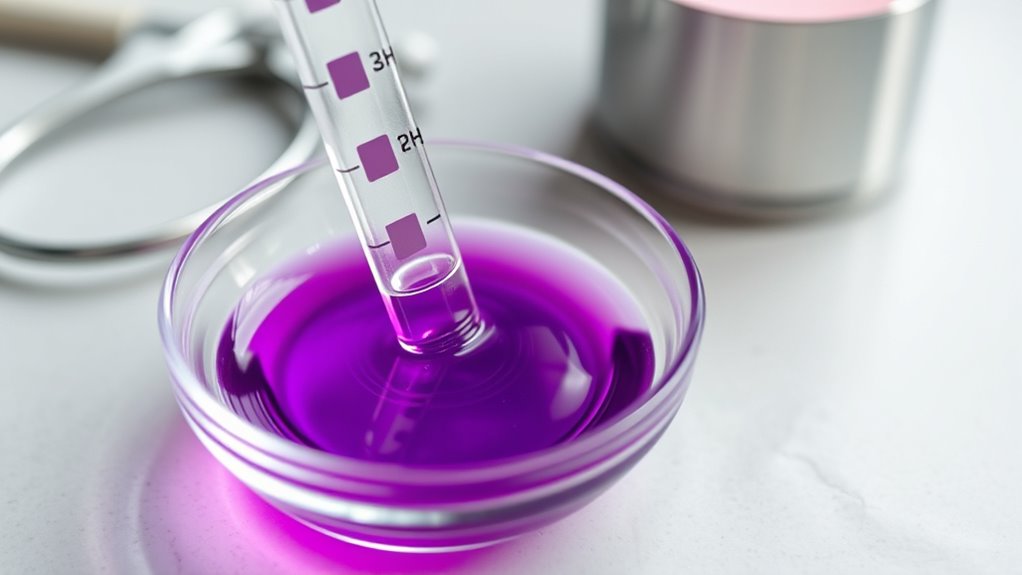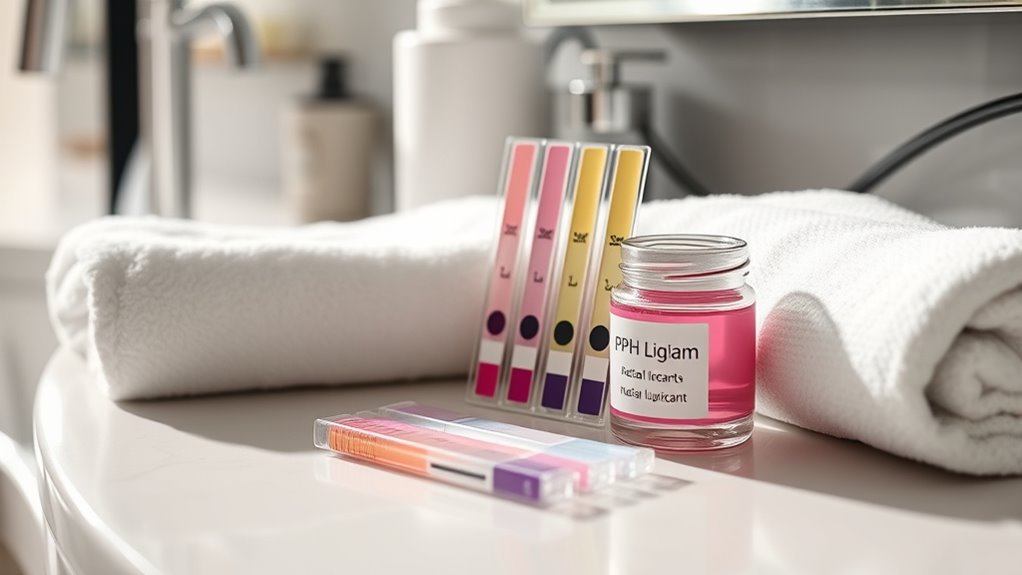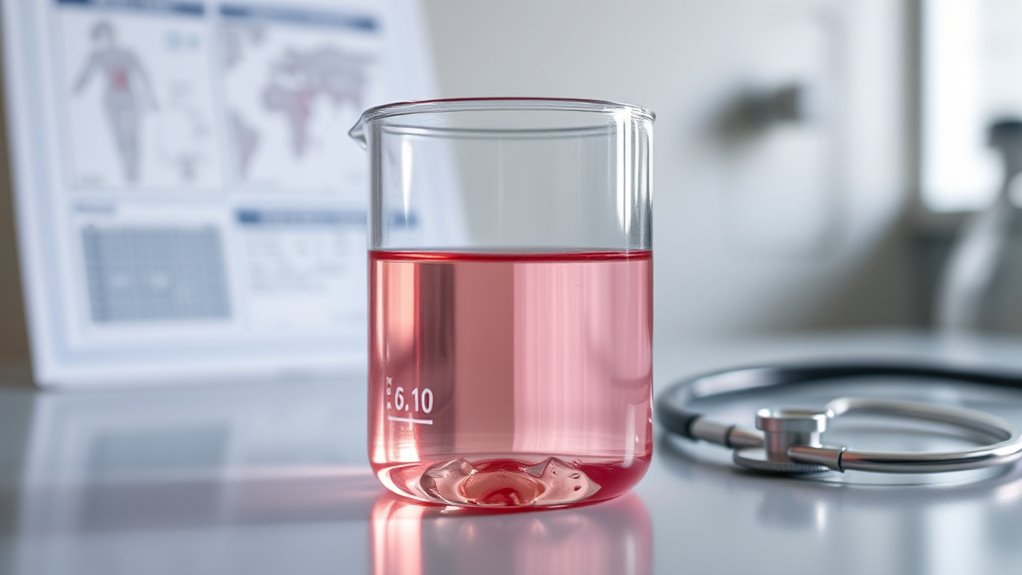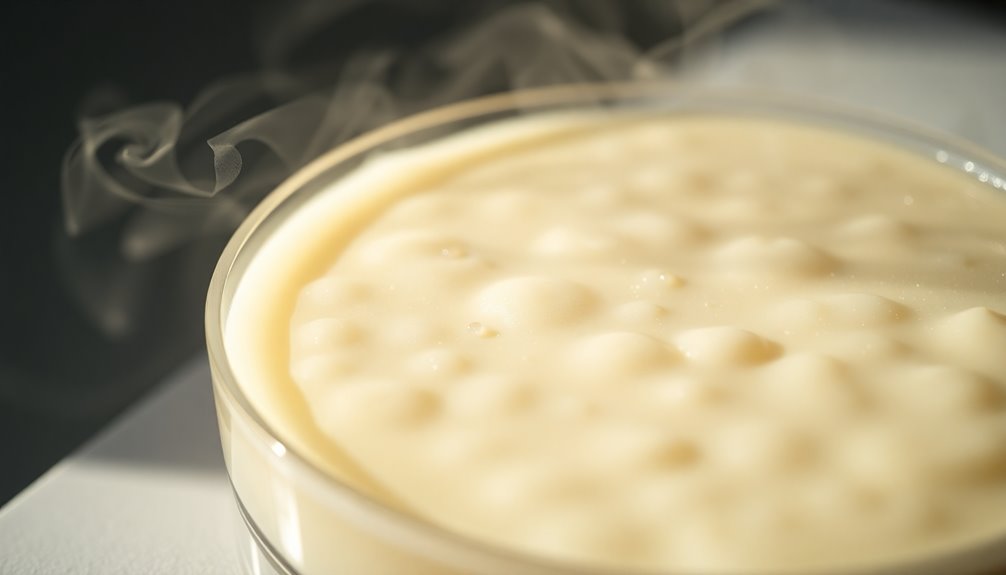Many myths surround vaginal pH, but it’s important to know that a healthy level typically ranges from 3.8 to 4.5, creating an acidic environment that fights infections. Slight fluctuations are normal due to factors like cycles or hygiene products. While some believe any change signals a problem, minor shifts often aren’t concerning. To learn more about maintaining balance and recognizing when to seek help, explore the full facts below.
Key Takeaways
- Slight pH fluctuations are normal; the vaginal pH typically ranges from 3.8 to 4.5.
- A higher or lower pH does not always indicate infection or health issues.
- Douching and scented products can disrupt pH but don’t always cause imbalance.
- Vaginal pH naturally varies during the menstrual cycle and due to hormonal changes.
- Maintaining hygiene with breathable clothing and probiotics supports healthy vaginal pH.
Understanding Normal Vaginal Ph Levels

Understanding what constitutes a normal vaginal pH is essential for recognizing what’s healthy. Typically, a healthy vaginal pH ranges from 3.8 to 4.5, creating an acidic environment that helps prevent infections. Your body naturally maintains this balance through beneficial bacteria called lactobacilli, which produce lactic acid. Factors like menstruation, sexual activity, or using certain products can temporarily alter this pH. It’s important to note that slight variations are normal, but significant shifts might indicate an imbalance. Maintaining a balanced pH supports overall vaginal health and reduces the risk of infections. Monitoring changes and practicing good hygiene can help keep your vaginal environment in check. Understanding your normal pH is a key step in recognizing what’s healthy for your body.
Common Myths About Vaginal Ph Debunked

Many common beliefs about vaginal pH are actually myths that can cause unnecessary concern or confusion. One myth is that your vaginal pH should always be perfectly neutral or acidic, but normal levels can vary slightly. Some think that douching or using scented products always disrupts pH, but occasional use doesn’t necessarily cause imbalance. Others believe that a higher pH always signals infection, but minor fluctuations are normal and not harmful. People also assume that vaginal pH is static, when in reality, it naturally changes throughout your cycle. Recognizing these myths helps you avoid unnecessary worry. Maintaining a healthy vaginal environment involves understanding what normal fluctuations look like, rather than fearing every change. Optimal angles for pinball machines can impact overall gameplay experience and longevity. So, don’t be misled by misconceptions—your body is more adaptable than you might think.
Factors That Can Alter Vaginal Ph

Various factors can influence your vaginal pH levels, potentially causing shifts that are normal or temporary. Hormonal changes during your menstrual cycle can cause fluctuations, making your pH slightly more acidic or alkaline. Using scented products like soaps, douches, or sprays can disrupt the natural balance, leading to a higher pH. Antibiotics and other medications may also alter your vaginal environment by killing beneficial bacteria. Sexual activity introduces new bacteria and fluids that can temporarily change pH levels. Stress and poor hygiene habits can upset the delicate balance, increasing the risk of imbalance. Additionally, certain health conditions, such as infections or hormonal disorders, can cause persistent pH changes. Maintaining vaginal health through proper hygiene and awareness of potential influences helps you understand that some variations are normal, but ongoing shifts might require attention.
How to Test and Maintain Healthy Vaginal Ph

Testing and maintaining your vaginal pH helps keep your vaginal environment healthy and balanced. To do this effectively, you can:
- Use over-the-counter pH test strips, which you dip into vaginal fluid or urine to check acidity levels.
- Track your symptoms and note any changes in odor, discharge, or discomfort that could signal pH imbalance.
- Follow a balanced diet rich in probiotics, yogurt, and fiber to support good bacteria.
- Practice good hygiene by wearing breathable cotton underwear and avoiding harsh soaps or douches.
- Be aware that maintaining a healthy vaginal pH also involves minimizing exposure to harmful pollutants, which can disrupt your natural balance and lead to infections.
Regular testing and mindful habits help you spot early signs of imbalance. Remember, maintaining a healthy pH supports overall vaginal health and prevents infections.
When to Seek Medical Advice for Vaginal Ph Concerns

If you notice persistent changes in your vaginal odor, discharge, or discomfort, it’s important to seek medical advice promptly. Unusual odor, thick or yellowish discharge, itching, burning, or pain may indicate an infection or imbalance that needs professional evaluation. Changes lasting more than a few days or worsening symptoms should not be ignored. Additionally, if you experience bleeding outside of your normal period, pelvic pain, or discomfort during urination or sex, consult a healthcare provider. These signs could point to underlying issues affecting your vaginal pH or overall vaginal health. Recognizing dream symbols related to health concerns can sometimes offer insight into underlying issues. Early diagnosis guarantees proper treatment and helps prevent complications. Trust your instincts—if something feels off or persists, make an appointment with your healthcare provider for personalized advice and care.
Frequently Asked Questions
Can Diet Influence Vaginal Ph Levels?
Your diet can definitely influence your vaginal pH levels. Consuming a balanced diet rich in fruits, vegetables, and probiotics helps maintain healthy bacteria, which keeps your pH in check. Avoiding excessive sugar and processed foods reduces the risk of imbalance. Staying hydrated and practicing good hygiene also support a healthy vaginal environment. By making smarter food choices, you help your body naturally regulate pH and prevent infections.
Do Menstrual Cycles Affect Vaginal Ph Fluctuations?
Your menstrual cycle does influence vaginal pH fluctuations. During your period, the pH tends to become more alkaline due to blood’s higher pH, which can slightly alter the vaginal environment. Around ovulation, the pH may become more acidic, supporting healthy bacteria. These natural changes are normal, but if you notice persistent discomfort or unusual odor, consult a healthcare professional to rule out infections or imbalances.
Are Natural Remedies Effective in Balancing Vaginal Ph?
Think of natural remedies as your trusty Swiss Army knife—useful, but not always the magic fix. You might find that certain remedies like probiotics or tea tree oil help restore your vaginal pH, but their effectiveness varies. it is crucial to consult your healthcare provider before trying them. While some women notice relief, others may see no change. Natural remedies can support balance, but they’re not guaranteed to work for everyone.
How Does Sexual Activity Impact Vaginal Ph?
When you engage in sexual activity, it can temporarily change your vaginal pH. Semen is alkaline, so it often raises the pH level, making it less acidic. This shift can disrupt the natural balance, leading to discomfort or increased infection risk. However, your body typically restores the normal pH within a few hours. To maintain healthy balance, practice good hygiene and consider using pH-balanced products.
Can Douching Permanently Alter Vaginal Ph?
You might think douching is a quick fix for discomfort, but it actually can permanently alter your vaginal pH. Douching washes away healthy bacteria and disrupts your natural balance, making your vagina more vulnerable to infections. Ironically, what’s meant to clean can cause long-term harm. So, unless you want to upset your delicate pH, it’s best to avoid douching and trust your body’s natural defenses.
Conclusion
Understanding your vaginal pH isn’t just about numbers; it’s about nurturing your health. By debunking myths and knowing what influences your pH, you hold the power to maintain balance and prevent discomfort. Remember, your body whispers its needs—are you listening? Stay vigilant, test regularly, and seek help when needed. Because in the symphony of your health, your vaginal pH is the quiet note that keeps everything in harmony.









